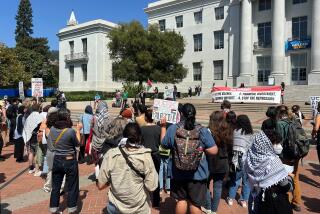Campus taming wild cat problem
- Share via
Pulling into the parking lot on West Campus Drive at Cal State Long Beach, Dorothy Burstein figured that the cats would recognize the rumble of her Honda Accord.
If that didn’t perk up their ears, the sound of her popping open the car trunk surely would.
“That means food,” she said.
Burstein is a volunteer with a small nonprofit group that for the last 10 years has been quietly feeding the dozens of feral cats that live on the fringe of the university campus.
But the group, Campus Animal Assistance-Beach Cats, became the focus of attention last summer after two coyote sightings at the school stirred concerns about students’ safety. University officials were worried that the cats were attracting the coyotes and on July 7 ordered Burstein’s group to remove the estimated 150 animals from the campus.
The group was initially given 40 days to complete the task.
Since then, Burstein said, her group, which includes three other volunteers, has captured 65 cats and has found homes or an adoption agency for 53 of them. She said they are now hoping to tame the remaining felines, about 90% of which she said have been sterilized.
A California Department of Fish and Game investigation concluded that campus trash and food from more than a dozen cat feeding stations were largely responsible for luring the coyotes to campus. Burstein noted that 14 cats were eaten by the coyotes.
Bowing to public protests, school officials recently struck a compromise with Burstein’s group. Officials approved a policy that would reduce the number of feline feeding stations from 15 to seven and limit feeding to 6 a.m. to 6 p.m.
The new policy is to take effect in two months. But school officials said that the steps already taken to control the cat population have proved effective.
“There is a higher comfort level now that we have a feral cat population that is managed in a way that will not interfere with campus life,” said Mary Stephens, the university’s vice president for administration and finance.
Some students said they have noticed a difference, with the cats less visible on campus.
“They’re mostly in bushy areas when it’s dark,” freshman Kim Middleton said. “They’re never out walking in open areas.”
The university’s actions contrast sharply with Los Angeles County Supervisor Don Knabe’s order on Oct. 23 to remove up to 200 feral cats from the Rancho Los Amigos National Rehabilitation Center in Downey. The county’s Department of Animal Care and Control will trap the cats and move them to a local shelter.
Not everyone is satisfied with the new policy at Cal State Long Beach.
Nancy Peterson, feral cat manager for the U.S. Humane Society, wrote a letter to Stephens about her organization’s concerns before the university drafted its proposal, saying that reducing the number of feeding stations would only concentrate the cat population, making them more conspicuous on campus.
“I was trying to point out that the administration’s goal and the goal of the caretakers are to reduce the number of feral cats on campus,” Peterson said. “The proposed regulations will not accomplish that.”
University officials said they decided on fewer feeding stations so there is not as much food in each area that could attract other animals, such as raccoons, possums and coyotes.
“There wasn’t just one perspective on this,” Stephens said. “We’re trying to be rational and realistic.”
--
More to Read
Sign up for Essential California
The most important California stories and recommendations in your inbox every morning.
You may occasionally receive promotional content from the Los Angeles Times.










